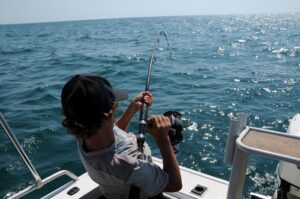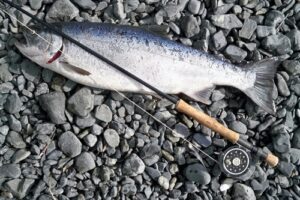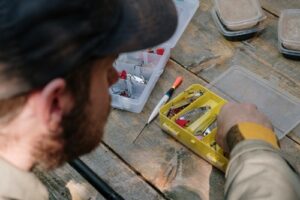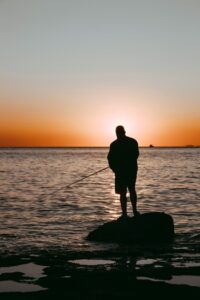Fishing Tips For Beginners And Fishing Hacks And Tips For The Advanced Angler

Fishing is fun, but it can be challenging. To get the most of it, there are some simple ideas and fishing hacks you can do to make it easier and more productive.
So here are some fishing tips for beginners.
Tape the rods together.
Use painters tape to hold rods together when traveling and to stop them from rattling.
The painters tape shouldn’t mark your rods and fishing gear. You only need a few wraps, otherwise it is hard to undo.
You can also use a small section of tape over the fishing hook to stop it coming off the hook keeper, or runners and getting tangled.
Hook keeper hack.
The hook keeper is a place to secure your fishing hook. A lot of rods have them, but unfortunately, not all rods do.
So here is a simple fishing hack to do if your rod doesn’t have one. Use a cable tie and small split ring to make one.
Place the split ring over the cable tie. Put the cable tie, slide it up firmly on the rod. Trim the end of the cable tie. Now you have a quick and easy place to keep the hook on the rod.
Threading the line.
Trying to thread a fishing line through the rod runners can be a pain. So one easy tip is to double the end line over.
This will help go through the fishing rod runners quicker and easier.
Fishing hotspots, where to fish?

Finding some places to fish, or good fishing spots can be hard. So, do your homework first.
Look at some fishing maps and mariners maps, for structures and drop offs.
Use google maps. Visit fishing forums or pop into a fishing club.
Talk to fisherman at fishing jetties, or boat ramps. Park Rangers, Fisheries and Wildlife officers can be a wealth of information about local hotspots.
While you are getting some bait from the local bait and tackle stores, have a chat about where to start.
Scan the water first.
Scan the area first before you cast your first lure, fly or bait.
If you rush down to the water’s edge, you might miss, exactly where to set up.
Watch what food sources are around the water. Are there weed beds, or submerged trees were the fish might be? Are there birds feeding on insects, or fish on the water?
Study the area before casting, too make sure you are in the best possible spot.
For more information visit Fly Fishing Tips And Tricks. While this article is more aimed at the fly fisherman, any type of angler might get some ideas about looking at where the fish might be and the food sources around.
At the boat ramp, get ready.
Before you back the boat down the boat ramp, make sure you have your rods organized, gear ready and life jackets out, etc.
Preparing and having the fishing equipment set up in the boat on land, is easier doing it than in the water and safer.
As an example, get the anchor ready in the boat beforehand. Then when you motor off and it is a bit choppy and unfortunately you have engine trouble, you can easy throw the anchor out. This saves trying to get it out under the bow or storage compartment.
Another example is, you get the landing net out and put it in its proper spot in the boat for easy access, before you back the boat in the water.
As opposed to you pulling up at your fishing spot, cast out the rods. Within minutes you have a nice fish on, but your searching for the landing net and realize it is tucked under the bow of the boat and is hard to get to it, while playing the fish.
As long as the items aren’t going to get knocked around or in the way when boating, (Or a safety issue like standing your rods up vertically in the rod holders, and there are overhead electrical wires when backing in the boat down the ramp.) then arrange your gear first in the carpark, boat ramp.
Prepare your gear first at home.

This tip is organizing your fishing equipment before you even step foot outside.
If you are planned for going fishing early next morning, prepare your gear the night before. Then it saves you changing hooks, lines, etc. at the fishing spot. Organizing your fishing equipment beforehand, saves a lot of valuable fishing time.
Change your leaders or tippets if they are worn at home first.
Replace those treble hooks on the lures.
Clean your fly line, or lubricate those fishing reels.
Does the filleting knife need sharpening?
Does the boat need some gas? Has the fuel been checked?
Are the boat trailer lights work?
Doing some maintenance, repairs with your rods and tackle at home, is easier than doing it at the fishing spot.
This tip not only saves you time, but also you have confidence that your tackle is 100% ready to go for the big fish.
Safety first.
Here are a few safety fishing tips for beginners.
Even if you are not fishing in remote places it is good to have some safety gear or prepare in case there is an emergency.
Like having a personal first aid kit with you. Or putting your cell phone in a dry bag.
If you are fishing near cold water from the bank, have a few lighters and packs of matches in a dry bag or two snap lock bags and some dry tinder to light. If you fall in the icy waters, you have some way of warming yourself up.
Do a first aid course.
For boat fishing, make sure you have flares, safety gear and life jackets or PFDs. Ensure the flares and fire extinguisher is in date.
Always tell someone where you are going fishing and when you should return.
Save time cleaning the fish.
Save some time when fishing.
If you are going to fillet the fish, (Remove the skin from the flesh.) there is no sense in scaling the fish.
Another time saving tip is if you have caught a few fish are fishing, but now the fish have stopped biting, clean your fish.
(Obviously if you are in bear country fishing, don’t do it then and there. Or if there are predators around the water, don’t clean the fish too close to the water’s edge.)
This saves you time, rather than cleaning the fish later on. Also I know when you travel home from a long trip, the last thing you want to do is clean the fish after you have unpacked your fishing equipment.
As well as it saves you time, when you clean the fish you can check and see what it is feeding on. This is a great tip for catching trout, bass and saltwater fish. A lot of times I have used the content that is in the fish’s stomach and used it for bait fishing.
For some places, cleaning your fish in the water also acts as chum or burly, attracting other fish.
Check your local rules about where you can and can’t clean your fish.
Foam pool noodle hacks.
A cheap all-rounder that you can use for fishing hacks, is the simple pool noodle.
There are 101 uses and fishing hacks for the pool noodle. Well maybe not 101, but there are dozens.
Use a short section to put the hooks into it safely, so they don’t catch on anything.
You might roll the leaders around the noodle and hooks set in to the foam. Or you wrap a fishing trotline all set up ready to go on the noodle.
You can use sections of the pool noodle for floats, or buoys on fish bait traps.
For fly tying, use a small bit of the pool noodle foam to build out the bodies of flies and make it buoyant.
Place a bit on the anchor rope, close to the boat. If you do have to ditch you anchor b (Check to see that the anchor rope you are using is not too heavy for it.)
For transporting the rods, I split the pool noodle sideways. This slit then goes over two rods to keep them from rattling.
If you have bigger diameter rods, place one section over one rod. You can then have a few rods, bumper to bumper and it keeps them from scratching together.
Use an elastic strap, (Octopus strap.) to bundle then together. Or Velcro webbing.
For kayak fishing, you can use long pool noodles for extra bouncy in the hull.
If you are transporting a couple of canoes or kayaks, (Seem my article on the Difference Between Kayak And Canoe.) use sections to place between gear so they don’t rub, or scratch.
Fish around structures.
Fish love hanging around structures like weed beds, reefs, drop offs, submerged trees and logs, dam walls, etc.
This is shelter and a food source all in one with some of these places.
Fishing tips for beginners, practice your knots.
When the fish are jumping about in a frenzy feeding, it can be hard to tie some good fishing knots, quickly and properly.
So practice at home first in the relaxed environment at home, where the children are yelling and fighting and the wife is nagging you to do chores. (Please don’t tell her I said that.)
I would like a dollar for every time I have hurried tying on a hook and I fumbled it. So I had to tie it again, causing lost fishing time.
Keep your hooks very sharp.

This is a good tip for bass fishing, or any fish for that matter, keep your hooks sharp.
It is easy to neglect the hooks and they can go rusty easy. So touch them up, to hook the fish easier.
Monitor the temperature.
If you chase fish that don’t like excessive heat, like trout, on a warm day they might be deeper down in the cool. Or around shady spots like overhanging banks, or under the shady spots of willow trees, etc.
Fish around some deeper pools, or drops off where the water temperature, or oxygen is better for the fish.
Outlets of freshwater flowing into lakes and rivers, might be worth fishing as the oxygenated water might be cooler.
Likewise for fish that enjoy the warm water, they might be feeding higher up in the water column, or feeding right on the surface.
Try two baits on the one hook.
Some fish can be picky, so try two different baits on the one hook.
Also for some bait that turns to mush easy and it falls of your hook easy, you still should have another bait on your hook.
A soft smelling bait, combined with a firmer bait can be effective for both freshwater fishing and saltwater.
Increase your chances, more rods.
Check your local fishing rules and regulations, but if you can, increase your chances of catching some fish, by using more rods.
If the boat is crowded and you have two rods out the back of the boat, do some jigging over the side of the boat.
Or throw a hand line over the side and do some hand line jigging.
Increase your chances, more hooks.
You may not be allowed to have more than two rods fishing, but sometimes you are allowed to have a few hooks on one rod.
If you are fishing from a jetty, or boat, where there is little chance of snags, try a couple of hooks on one line. See if it helps improve your catch rate?
If you are fly fishing you might have a dry fly with a dropper that has a nymph pattern on it. You can use the dry as a visual strike indicator as well.
For fly fishing deep lakes, I have used a bigger streamers and a smaller buoyant fly in front of it. The heavier streamer and buoyant fly being retrieved quickly gives it some good erratic movement. It looks like the streamer pattern is chasing the smaller fly. Interesting I have had the smaller fly being taken more than the larger streamer.
Take some plastic bags.
Plastic bags are very handy to take fishing.
From putting the cleaned fish in it and putting it on ice, to putting some rubbish in it. Just don’t let it blow away and make more rubbish.
Has some in your vehicle, boat or one in your fishing vest.
Fishing licenses.
Remember you’re fishing license.
For electronic fishing licenses and receipts take a screen snap of it. Send the picture to you partner, or fishing buddy. That way if you do lose your phone, you still have a copy of your fishing license you can view.
While lot of licenses are electronic version, some are the still the old fashion way. So take a photo of the hard copy version of it as well.
To find out how much a fishing license is in Texas, click on – How Much Is A Texas Fishing License?
.if you plan to fish in California, visit for more information – How Much Is A Fishing License In California?
Fishing in the dark.
Night fishing can be a great way to get away from the crowds and do some challenging fishing.
You also can come across some big fish that are feeding closer to the shore or are more active feeding at night.
For some tips and information click on, Night Fishing.
Shark fishing can be productive at night and a bit of an adventure.
Don’t stand with your back to the water when baiting up.
Surf fishing, rock fishing can be dangerous with big waves and swells.
So when you are putting on bait and getting your tackle ready, never stand with your back to the water, as you may not see the wave coming in.
Even if you are fishing a small river, don’t stand with your back to the water as you will miss the fish rising, and the insects moving.
Use a dry bag.
Dry bags are great for fishing and boating, with all types of sizes.
When boating, the dry bag not only stops items getting wet from the spray, but if it goes overboard it will float.
A dry bag can also be used as a makeshift bucket to get some water.
A dry bag is a necessity for kayak fishing, where you can store dry clothing. Which is handy having extra layers of clothing when you have cooled down from paddling.
Extra clothes.
Have a spare pair of cloths in the boat, or back at the car in case you get wet.
Wading in lakes, crossing rivers, getting in and out of the boat, there are a lot of chances to get wet. Especially fishing in the rain.
For kayak fisherman, I think a spare set of dry clothes in the car is a must.
Waterproof jacket.
Have waterproof coat or a jacket with you fishing, in case the weather changes.
Even if the weather is okay, fishing at sun down the temperature can really drop.
Proper clothing, hats and gloves can keep you warmer and concentrating on the fish biting.
Have an old piece of cloth?
Spare cloths, rags, old bandanas are great for fishing.
They can help hold the fish, when you first get it in the boat or bank. It can clean up the mess when cleaning the fish. Or wipe the gas or bait mess off your hands.
For kayak fishing it can be used to mop up some water in the bottom of the hull.
On very hot days fishing, you can dip a clean rag over the side of the boat and place the wet rag on your neck to help cool you down. (Or dip your hat in the water.)
Check the weather before you go.
Check the forecast before you go fishing.
While the forecast isn’t always 100% perfect, you can avoid fishing in bad weather or storms which can be dangerous.
Holding carbon fiber fishing rods in a boat, or wading in the water can be dangerous when there is storms and lightning about.
Bigger, smaller.
Have a few different hook sizes and lure sizes and experiment.
For timid fish a smaller diameter leader, or tippet and hooks might help fool the fussy fish.
For murky waters, a lure one or two sizes up can give more movement and vibration attracting the fish.
Likewise for calm clear waters you might have to go down a size.
Conclusion – Fishing tips for beginners.
There are plenty ideas to make fishing more enjoyable, safer and help increase your catch rate.
Good fishing and I hope these fishing tips for beginners and hacks, help you land some nice fish!
Extra Fishing Resources:
